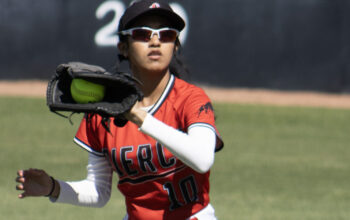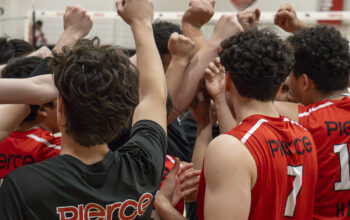Philip George / Roundup, Rachel Roth / Roundup
While many athletes follow the same path to the pros — playing for a Division I program straight out of high school — it is a common misapprehension that it is the only way to make it to “the big show.”
Adolfo Perez, head coach of the women’s soccer team since 2001, begs to differ. He thinks some students may not be emotionally ready for a four-year school at age 18.
“I think it’s a misconception people have that you have to go (to a four-year university) straight out of high school,” he said. “Every individual is different. There’s some kids that aren’t ready, whether it’s academically or they don’t want to leave home.”
According Bob Lofrano, Pierce College athletic director, academics are typically the reason Division I prospects choose to play at Pierce before transferring.
When Lofrano served as head baseball coach, the first question he would ask prospects was regarding their grade point average because kids with low GPAs generally go to community colleges.
He also said community colleges offer a chance for players to play, whereas at a bigger program they may be forced to ride the pine in favor of “top-notch” talent.
“They’re a cut above,” he said. “They’ll run a little bit faster, they’ll throw a little bit harder. Our guys come to Pierce because they don’t throw as fast, they don’t throw as hard or their grade point average deems that they have to go to a junior college.”
Lofrano added that when comparing a Pierce freshman up with a UCLA or USC freshman, the latter will generally be a better player. There are exceptions, however.
“(Baseball player James) Wharton is as good as anybody that went to UCLA as a freshman. In general the kid that goes to UCLA academically and even athletically is just a little bit ahead of our guy,” he said of the left fielder who put up stellar numbers — .361 batting average, 16 homeruns and 50 RBI in his first season with the Brahmas.
Wide receiver Jonas Matos left cross-town rival Valley College for Pierce in 2007 due to personal problems with Valley head coach Jimmy Sims.
“I wasn’t given a fair chance,” he said, but declined to elaborate.
Matos, who will play next year at American International University, credits his time at Pierce for preparing him for the next level.
“I honestly think that (community colleges) give athletes a taste of what’s going to be at the next level,” Matos said. “Maybe not a complete meal, but a taste.
“Once you leave junior college and another school takes you, you’re not going to ride the bench, you’re going to get playing time. Junior college players are players that (universities) expect to come in and contribute, and I think that’s what junior college is all about – giving somebody a second chance.”
For some Brahmas, playing at Pierce is a career decision. According to Major League Baseball rules, players who attend a four-year university straight out of high school cannot be drafted until their junior season or until age 21. However, if they attend a junior college, they are eligible for the draft after only their first season.
Prior to signing what was, at the time, the most lucrative contract for a pitcher in MLB history, former Cy Young award winner and current San Francisco Giant Barry Zito called Pierce and Joe Kelley Field home.
Zito played one year for Pierce in 1998. Lofrano, head coach at the time, remembers Zito as being a good student but “a little flakey,” often surfing before school.
“In Barry’s case, from high school he went to (University of California, Santa Barbara),” Lofrano said. “It was a family decision to come to a junior college because he then made himself eligible for the draft.
“He was drafted out of here by the Texas Rangers and turned that opportunity to sign (down). Went to USC in his third year in college. Was All-American in 1999 and a number-one pick by the Oakland A’s,” he continued.
Zito isn’t the only high-profile athlete to come through Pierce (see sidebar), and Lofrano said many remember where they came from.
Some former Brahmas, like Zito and former MLB third baseman Doug DeCinces, donate money to their old program. Others donate time — former professional quarterback Erik Kramer attended a pre-game pancake breakfast with the football team.
Playing sports at a community college is not a roadblock on the path to professional sports. It is also not something to be ashamed of.
Head football coach Efrain Martinez thinks of community college athletics as an opportunity to begin anew.
“We’ve had a pretty high success rate of getting guys who were overlooked in high school and were academically qualified to go to a four-year school,” Martinez said. “(They) opted not to because they wanted to improve themselves at the junior college level.
“Either way, we look at it as a second chance.”



